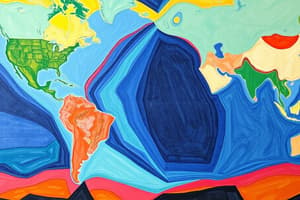Podcast
Questions and Answers
What is plate movement a result of in terms of the Earth's structure?
What is plate movement a result of in terms of the Earth's structure?
- The movement of the Earth's lithosphere (correct)
- The movement of the Earth's crust
- The movement of the Earth's core
- The movement of the Earth's mantle
What is the process by which new crust is formed as magma rises to fill the gap between two plates?
What is the process by which new crust is formed as magma rises to fill the gap between two plates?
- Convergent motion
- Subduction
- Transform motion
- Divergent motion (correct)
What is the study of the Earth's magnetic field as recorded in rocks?
What is the study of the Earth's magnetic field as recorded in rocks?
- Paleontology
- Seismology
- Paleomagnetism (correct)
- Geology
What force is exerted by the creation of new crust at mid-ocean ridges?
What force is exerted by the creation of new crust at mid-ocean ridges?
What is the primary driving force behind plate movement?
What is the primary driving force behind plate movement?
What is an example of convergent motion?
What is an example of convergent motion?
What is the term for the process by which one plate is pushed beneath another?
What is the term for the process by which one plate is pushed beneath another?
What is the average rate of plate movement?
What is the average rate of plate movement?
What is the term for the movement of plates past each other horizontally?
What is the term for the movement of plates past each other horizontally?
What is the evidence that suggests that continents were once joined together?
What is the evidence that suggests that continents were once joined together?
Flashcards are hidden until you start studying
Study Notes
Plate Movement
What is Plate Movement?
- The movement of the Earth's lithosphere, which is the outermost solid layer of the planet
- The lithosphere is broken into several large plates that fit together like a jigsaw puzzle
Types of Plate Movement
- Divergent Motion: plates moving apart from each other
- New crust is formed as magma rises to fill the gap
- Examples: Mid-Ocean Ridges, East African Rift System
- Convergent Motion: plates moving towards each other
- Can result in subduction (one plate is pushed beneath another) or collision (plates collide and crumple)
- Examples: Andean mountain building, Himalayan orogeny
- Transform Motion: plates sliding past each other horizontally
- No creation or destruction of crust
- Examples: San Andreas Fault, North Anatolian Fault
Factors Affecting Plate Movement
- Convection Currents: slow circulation of hot, viscous rock in the Earth's mantle
- Drives plate movement by exerting forces on the base of the lithosphere
- Ridge Push: force exerted by the creation of new crust at mid-ocean ridges
- Pushes plates apart and drives divergent motion
- Slab Pull: force exerted by the sinking of dense, cold plate material into the mantle
- Pulls plates towards each other and drives convergent motion
Evidence for Plate Movement
- Fit of the Continents: the shape and fit of the continents, particularly Africa and South America
- Mid-Ocean Ridges: vast underwater mountain ranges formed by plate divergence
- Paleomagnetism: the study of the Earth's magnetic field as recorded in rocks
- Shows that the Earth's magnetic poles have reversed over time, and that the rocks have moved over time
Studying That Suits You
Use AI to generate personalized quizzes and flashcards to suit your learning preferences.




